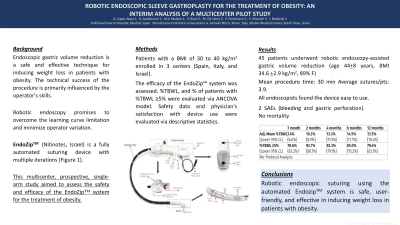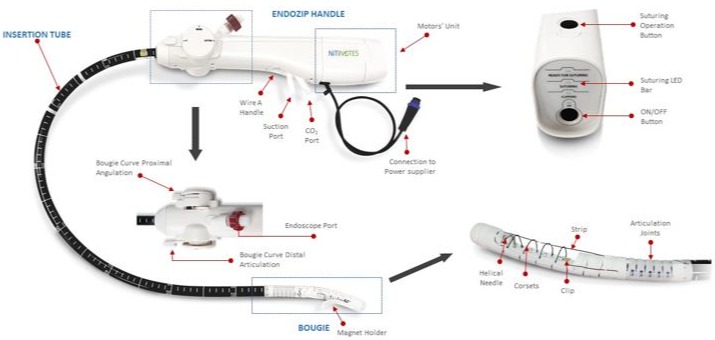Monday Poster Session
Category: Obesity
P2607 - Robotic Endoscopic Sleeve Gastroplasty for the Treatment of Obesity: An Interim Analysis of a Multicenter Pilot Study
Monday, October 23, 2023
10:30 AM - 4:15 PM PT
Location: Exhibit Hall

- IB
Ivo Boskoski, MD, PhD
Fondazione Policlinico Universitario A. Gemelli IRCCS
Rome, Lazio, Italy
Presenting Author(s)
Gontrand Lopez-Nava, MD, PhD1, Asokkumar Ravishankar, MD1, Maria Valeria Matteo, MD2, Vincenzo Bove, MD2, Valerio Pontecorvi, MD, PhD2, Martina De Siena, MD2, Steven E. Shamah, MD3, Ivo Boskoski, MD, PhD2
1HM Sanchinarro Hospital, Madrid, Madrid, Spain; 2Fondazione Policlinico Universitario A. Gemelli IRCCS, Rome, Lazio, Italy; 3Rabin Medical Center, Petah Tiqwa, Tel Aviv, Israel
Introduction: Endoscopic gastric volume reduction is a safe and effective technique for inducing weight loss in patients with obesity. They function mainly by inducing satiation and satiety and impacting gastric motility. However, the technical success of the procedure is primarily influenced by the operator's skills. The available endoscopic techniques have a significant learning curve to achieve mastery over the technique. Robotic endoscopy promises to overcome the learning curve limitation and minimize operator variation. Our early experience with automated robotic endoscopy (EndoZipTM, Nitinotes, Israel) for endoscopic gastric volume reduction has been shown to be safe. The device has been made more sophisticated and fully automated with multiple iterations (Figure 1). We aim to present the safety and efficacy of the newer, fully automated robotic endoscopic suturing system for obesity.
Methods: This multicenter, prospective, single-arm study aimed to assess the safety and efficacy of the EndoZip™ system for the treatment of obesity.
Patients with a BMI of 30 to 40 kg/m2 unable to lose weight with non-invasive approaches and deemed suitable for bariatric endoscopic according to the multidisciplinary team were enrolled in 3 centers (Spain, Italy, and Israel). The efficacy of the EndoZip™ system was assessed. %TBWL, and % of patients with %TBWL ≥5% were evaluated via ANCOVA model. Safety data and physician's satisfaction with device use were evaluated via descriptive statistics.
Results: Forty-five patients underwent robotic endoscopy-assisted gastric volume reduction. The mean +SD age was 44 +8 years, and BMI was 34.6 +2.9 kg/m2, respectively. The majority of the patients were female (89%). the average procedure time was 30 minutes. We used an average of 3.9 sutures; At 12 months, the mean +SD %TBWL was 13.5 + 10.4%. We observed >5% TBWL in 79.4% of the patients (Table 1). All endoscopists found the device easy to use. Serious adverse events occurred in 2 patients (bleeding and gastric perforation). The bleeding was stopped with endoscopic clipping, and the gastric perforation required surgical closure. No mortality occurred.
Discussion: Robotic endoscopic suturing using the automated EndozipTM system is safe, user-friendly, and effective in inducing weight loss in patients with obesity.

Disclosures:
Gontrand Lopez-Nava, MD, PhD1, Asokkumar Ravishankar, MD1, Maria Valeria Matteo, MD2, Vincenzo Bove, MD2, Valerio Pontecorvi, MD, PhD2, Martina De Siena, MD2, Steven E. Shamah, MD3, Ivo Boskoski, MD, PhD2. P2607 - Robotic Endoscopic Sleeve Gastroplasty for the Treatment of Obesity: An Interim Analysis of a Multicenter Pilot Study, ACG 2023 Annual Scientific Meeting Abstracts. Vancouver, BC, Canada: American College of Gastroenterology.
1HM Sanchinarro Hospital, Madrid, Madrid, Spain; 2Fondazione Policlinico Universitario A. Gemelli IRCCS, Rome, Lazio, Italy; 3Rabin Medical Center, Petah Tiqwa, Tel Aviv, Israel
Introduction: Endoscopic gastric volume reduction is a safe and effective technique for inducing weight loss in patients with obesity. They function mainly by inducing satiation and satiety and impacting gastric motility. However, the technical success of the procedure is primarily influenced by the operator's skills. The available endoscopic techniques have a significant learning curve to achieve mastery over the technique. Robotic endoscopy promises to overcome the learning curve limitation and minimize operator variation. Our early experience with automated robotic endoscopy (EndoZipTM, Nitinotes, Israel) for endoscopic gastric volume reduction has been shown to be safe. The device has been made more sophisticated and fully automated with multiple iterations (Figure 1). We aim to present the safety and efficacy of the newer, fully automated robotic endoscopic suturing system for obesity.
Methods: This multicenter, prospective, single-arm study aimed to assess the safety and efficacy of the EndoZip™ system for the treatment of obesity.
Patients with a BMI of 30 to 40 kg/m2 unable to lose weight with non-invasive approaches and deemed suitable for bariatric endoscopic according to the multidisciplinary team were enrolled in 3 centers (Spain, Italy, and Israel). The efficacy of the EndoZip™ system was assessed. %TBWL, and % of patients with %TBWL ≥5% were evaluated via ANCOVA model. Safety data and physician's satisfaction with device use were evaluated via descriptive statistics.
Results: Forty-five patients underwent robotic endoscopy-assisted gastric volume reduction. The mean +SD age was 44 +8 years, and BMI was 34.6 +2.9 kg/m2, respectively. The majority of the patients were female (89%). the average procedure time was 30 minutes. We used an average of 3.9 sutures; At 12 months, the mean +SD %TBWL was 13.5 + 10.4%. We observed >5% TBWL in 79.4% of the patients (Table 1). All endoscopists found the device easy to use. Serious adverse events occurred in 2 patients (bleeding and gastric perforation). The bleeding was stopped with endoscopic clipping, and the gastric perforation required surgical closure. No mortality occurred.
Discussion: Robotic endoscopic suturing using the automated EndozipTM system is safe, user-friendly, and effective in inducing weight loss in patients with obesity.

Figure: EndoZIp Disposable Device
Disclosures:
Gontrand Lopez-Nava: Apollo Endosurgery – Consultant. USGI Medical – Consultant.
Asokkumar Ravishankar: Apollo Endosurgery – Consultant.
Maria Valeria Matteo indicated no relevant financial relationships.
Vincenzo Bove: Apollo Endosurgery – Consultant.
Valerio Pontecorvi indicated no relevant financial relationships.
Martina De Siena indicated no relevant financial relationships.
Steven E. Shamah indicated no relevant financial relationships.
Ivo Boskoski: Apollo Endosurgery – Consultant, Grant/Research Support. Boston Scientific – Consultant. Cook Medical – Consultant. Endotools – Advisory Committee/Board Member. Nitinotes – Consultant.
Gontrand Lopez-Nava, MD, PhD1, Asokkumar Ravishankar, MD1, Maria Valeria Matteo, MD2, Vincenzo Bove, MD2, Valerio Pontecorvi, MD, PhD2, Martina De Siena, MD2, Steven E. Shamah, MD3, Ivo Boskoski, MD, PhD2. P2607 - Robotic Endoscopic Sleeve Gastroplasty for the Treatment of Obesity: An Interim Analysis of a Multicenter Pilot Study, ACG 2023 Annual Scientific Meeting Abstracts. Vancouver, BC, Canada: American College of Gastroenterology.
